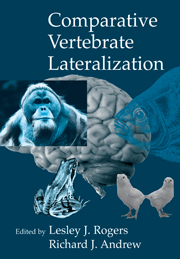Introduction
Published online by Cambridge University Press: 10 December 2009
Summary
Interest in lateralization of function in a non-human vertebrate species was stimulated by Fernando Nottebohm's finding of differential effects on song production of sectioning the left and right tracheosyringeal nerves supplying the musculature of the avian syrinx (Nottebohm, 1971). He found that, in the canary, severing the left nerve impairs singing, whereas severing the right nerve has no effect on song. Within the next decade, such lateralization of song control had been traced to centres in the forebrain (Nottebohm, Stokes and Leonard, 1976), and Victor Denenberg and colleagues had discovered lateralization in the rat brain for control of activity and emotional responses (Denenberg et al., 1978; Denenberg, 1981). The latter had also been reported by Bianki, whose work received less recognition in the Western world largely because he was based in Russia (in translation Bianki, 1988). Also, in the next decade, lateralization for visual responding had been discovered in the domestic chicken brain, shown first by unilateral treatment of the forebrain hemispheres with either cycloheximide (Rogers and Anson, 1979) or glutamate (Howard, Rogers and Boura, 1980). Treatment of the left hemisphere led to a set of behavioural changes that differed from those resulting from the same treatment of the right hemisphere.
- Type
- Chapter
- Information
- Comparative Vertebrate Lateralization , pp. 1 - 6Publisher: Cambridge University PressPrint publication year: 2002
- 2
- Cited by



